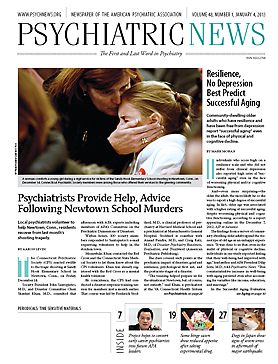Too much, too little, or just right?
Are American adolescents with psychiatric disorders over- or under-prescribed psychotropic medications? The controversy flares up frequently in the professional and lay media, but a new National Institute of Mental Health (NIMH) study says that these medications are “prescribed appropriately.”
“There was no compelling evidence for either misuse or overuse of psychotropic medications,” wrote Kathleen Merikangas, Ph.D., chief of the Genetic Epidemiology Research Branch in the Intramural Research Program at NIMH, and colleagues, online December 3, 2012, in the Archives of Pediatric and Adolescent Medicine.
The study, which was funded by NIMH, “very clearly refutes the prejudicial view that youth are overmedicated,” said Joseph Biederman, M.D., chief of the clinical and research programs in pediatric psychopharmacology and adult ADHD at Massachusetts General Hospital and a professor of psychiatry at Harvard Medical School. “In fact, the rates of disorders way exceed the rates of treatment.” Biederman was not involved with the NIMH study.
The researchers collected data from 10,123 adolescents aged 13 to 18 from 2001 to 2004 as part of the National Comorbidity Survey—Adolescent Supplement (NCS-A). Besides gathering demographic and medication information, trained lay interviewers used a version of the World Health Organization’s Composite International Diagnostic Interview to assess the presence of mood, anxiety, substance use, eating, and behavior disorders. Stated medication use was checked against prescription bottles, when possible.
The research builds on earlier reports from the NCS-A that found a high frequency of psychiatric disorders but only modest levels of treatment for them (Psychiatric News, April 15, 2011).
About 24.9 percent of the young people assessed received mental health services in the prior year, and 14.2 percent of those with a mental disorder said they were treated with a psychotropic medication, Merikangas noted.
Just 2.5 percent of those receiving such drugs did not have a 12-month DSM-IV disorder, but 78 percent of those adolescents had a lifetime history of psychiatric or developmental impairment.
Patients receiving psychotropic medications were also more likely to be treated in mental health specialty settings than in primary care settings.
Because the survey did not include questions about schizophrenia or obsessive-compulsive disorder, said Merikangas, “it is likely that an even smaller percentage of adolescents would be found to have no objective mental health need for psychotropic treatment.”
Less than half of young people diagnosed with either depression or attention-deficit/hyperactivity disorder (ADHD) received antidepressants or stimulants, respectively, suggesting to Biederman a pattern of under- rather than over-treatment.
Ethnic-minority youth recorded lower prevalence rates of medication use compared with white youth. Family income was inversely associated with antidepressant use, while children of parents who did not finish high school reported more prescribed stimulant use than did those with better-educated parents.
Antipsychotic use was rare, most often found among youth with neurodevelopmental or bipolar disorders, plus some with ADHD and behavioral disorders.
Only 15 percent of the NCS-A respondents fell below the poverty line, and that may have skewed the results, noted an accompanying editorial by David Rubin, M.D., M.S.C.E., codirector of PolicyLab at Children’s Hospital of Philadelphia and an associate professor of pediatrics at the Perelman School of Medicine at the University of Pennsylvania.
He suggested that publicly insured patients may be quickly moved onto drug therapy rather than into hard-to-find psychotherapy.
“The investments in nonpharmacological treatment options, in workforce development, and in better models of engaging families are simply lacking,” said Rubin. ■
